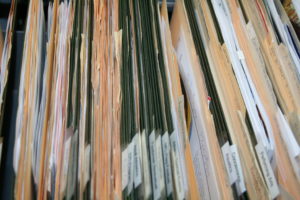The Reality of a Paperless Society
I’ve heard many times that computers would lead to a paperless society. Screens and keyboards would replace pen and paper. I’ve yet to see that vision come to fruition. In fact, I think computers help us generate more paper. After all, it’s very easy to print 10 copies of a meeting agenda, an instruction manual, or some other material needed for work. You simply click “print” and the rest is automatic. But if you think about it, is it really necessary to print all these documents? Or can you change your work habits a bit and find ways to reduce the amount of paper you produce, and become more efficient in the process?
I’ve recently worked with a client whose corporate culture encourages less printing. If they can avoid printing it, they will make every effort to do just that. It’s mandated in meetings – bring your laptop for notes and agendas. And there are signs located throughout the office touting the message of saving paper. While this may seem like an environmental agenda, it’s more about productivity and creativity – along with cost savings. Holding a paperless meeting is just one way to get there.
The Efficiency of the Paperless Meeting
In many ways, a paperless meeting is much more efficient. Rather than stacks of meeting agendas and materials, these documents can be emailed beforehand and referenced on a mobile device during the meeting. Laptops, tablets and smartphones make this very easy. This is particularly useful when meeting attendees are geographically distributed, as is the case with some executive boards. Notes can be typed directly into a meeting agenda, or otherwise captured for reference at a later date. No more stacks of scribbled notes crammed into a portfolio or cluttering your desk. Another great advantage is the ability to reference information that may not have been prepared beforehand. I recall a meeting recently where the subject of revenue came up. Rather than leave the meeting to print out copies of sales reports, we were able to bring up the information on the big screen and highlight the relative areas. This sort of collaboration helps attendees engage in the discussion, rather than doodle on a notepad. Then there is security. Have you ever accidentally left a sensitive paper document behind? By keeping it electronic, the normal safeguards you have built in is protecting the information.
Making Other People’s Paper Paperless
Although you can do a lot to reduce the amount of paper generated internally, what about externally generated paper? Vendors and customers will have paper documents that you have to deal with. Document management systems allow you to store paper documents in digital format, and retrieve the information much quicker than a filing cabinet would allow. The software helps organize electronic documents, similar to how you might physically organize it in storage. For example, a paper invoice received in the mail would be scanned and stored as a picture (JPEG) or Adobe (PDF) file. You can then drag the document into a folder, entering a few details on a form so that it’s placed in the right category. When you need to refer to it later, selecting the right document folder or using a simple search by name, date and category will yield the results. Depending on the system used, these documents can also search globally for text contained within it. Let’s say you are looking for a document with the word “Acer” in it. Simply type this into the search field and any document stored in the system with the word “Acer” in it will appear. Not only does this save time, but your documents are much more secure and better organized. And you can put the space taken up by filing cabinets to much better use!
Paperless and Paper Appropriate Realities
One of the best investments my company made in 2014 was to purchase a 60” flat screen TV. Rather than using it for entertainment, this TV is used for presentations. Displaying an agenda on a projector or big screen TV allows all participants to see information, and it can be manipulated in real-time. Often, we find ourselves going over process and software training. The ability to display this as a “show and tell” reduces the amount of time it takes to learn a new concept, and saves on printing the information.
I can’t discount the importance of paper. It’s one of the leading industries in our great State of Maine, creating jobs and helping the economy in northern areas of our land. And admittedly, picking up a newspaper or magazine is still something I like to do. Paper will have a place in our lives for a long time. But in an economy where efficiency wins, and costs are critical to control, I’m finding that going paperless is just a step in right direction.

Reader Interactions